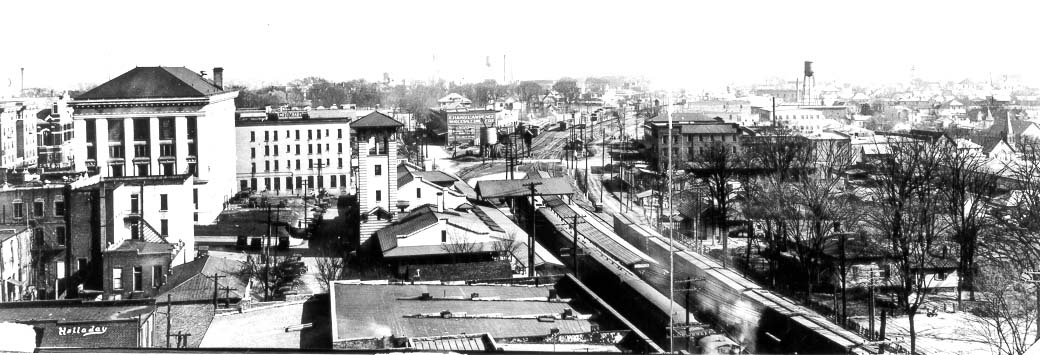Historic Durham
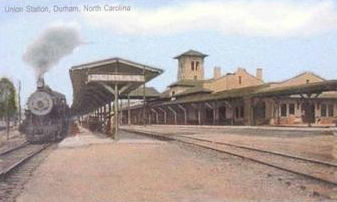
In 1852, Dr. Bartlett Snipes Durham sold four acres to the NC Railroad Co. for a train depot east of Pinhook (on the line connecting Goldsboro and Charlotte). While the train station has been torn down, Durham still radiates from the railroad tracks which were its reason for being and its lifeblood for 100 years.

Corner of Main & Roxboro streets in Durham (ca. 1880)

Malbourne Hotel: northwest corner of Main and Roxboro Streets (razed in 1967). Judicial building now stands at the site.
Downtown Durham in 1925. Left to right: courthouse, Union Station with railroad yards, and St. Joseph's AME Church (far right).

Biltmore Hotel and the Regal Theater on Hayti's Pettigrew Street in the 1940's. Hayti was a bustling black business district south of the tracks from downtown Durham. Hayti's demise came at the expense of "progress" -- the Durham Expressway. There were one hundred businesses, including movies, drugstores, a hotel (the Biltmore), restaurants, barber and beauty shops, cleaners, funeral homes, service stations, banks, insurance companies, etc. Unlike other cities in America, Durham was different in that blacks lived in other areas all over Durham. Areas such as Walltown, parts of Bragtown, Pearsontown, North Durham, Hayestown, East Durham, Factory Hill, the West End, the Bottom, College Hill, Brooks Town, Hickstown or Crest Street Community and so on. All these areas had their own blacked-owned businesses also. (source: Marshall Thompson)
Durham, 1891 (Erwin Mills arrived one year later, far left). Click to enlarge.
"In 50 years, Durham had spread rapidly from a village to a bustling factory center, sucking in the rolling pine country around it. Shacks for factory workers mushroomed in the lowlands between the graded streets. The little communities, which clung precariously to the banks of streams or sat crazily on washed out gullies and were held together by cowpaths or rutted wagon tracks, were called the Bottoms. It was as if the town had swallowed more than it could hold and had regurgitated, for the Bottoms was an odorous conglomeration of trash piles, garbage dumps, cow stalls, pigpens and crowded humanity ...."
-Pauli Murray ("Proud Shoes: The Story of an American Family")
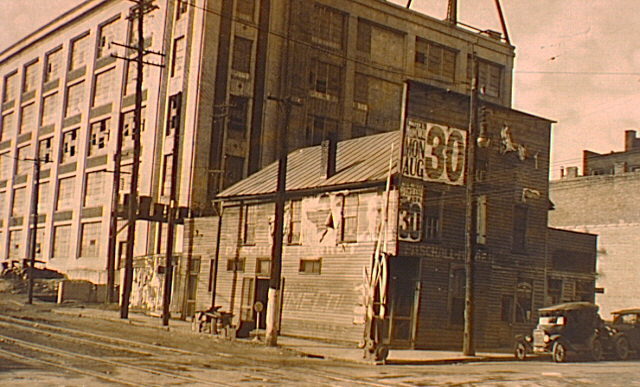
Saloon on downtown railroad tracks. Before the arrival of Erwin Mills
in West Durham, Pinhook was home to several saloons, grog shops and
other places of ill-repute. The city voted out saloons in 1902.
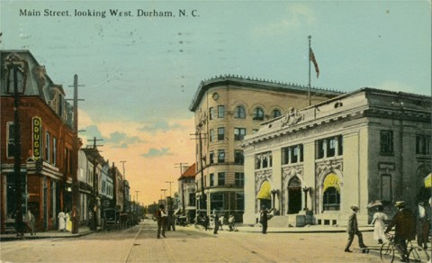
Downtown
Durham (looking toward Trinity College and West Durham).
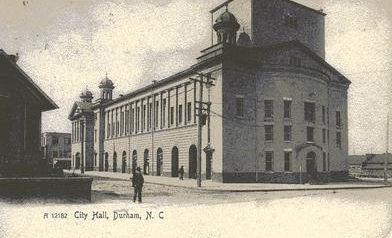
Durham's City Hall in 1909: public meetings were held
on the second floor -- above the sights, smells and sounds of a very
active city market. Later, City Hall moved into the old high school
(now Durham Arts Council). The old town auditorium moved from here into
the Carolina Theatre and the meat market moved to the corner of Foster
and Morgan streets. This site is now "Bare Square" (between
the CCB tower and the Blue Coffee Company). Today, the City Council
meets above the sights, smells and sounds of the City-County Planning
Department.
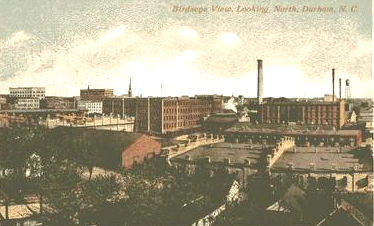
Early view of Durham's
skyline.
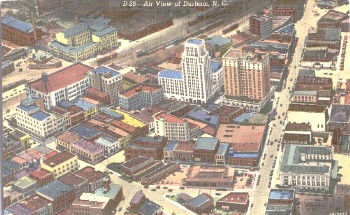
Aerial view of downtown: Opened in 1934, Durham's new
post office, white building with green roof in lower-right corner of
postcard, was built where two pioneer saloon keepers once kept their
homes (Atlas Rigsbee and William Mangum). In the previous decade, the
Washington Duke Hotel, tall brown building in middle-right, was built
where the old Academy of Music once stood. Just to the left of the hotel
stands the familiar CCB tower (white, modernistic 17-story skyscraper
which was first know as Durham Bank &
Trust).
 |
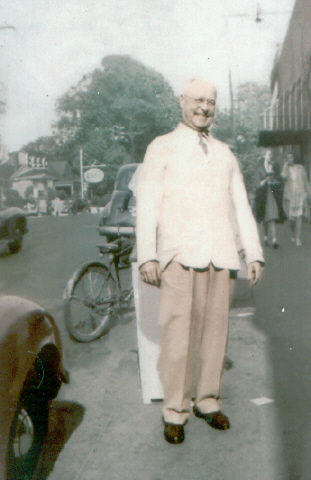
'Doc' Chapman ran the Owl Pharmacy on West Main Street, near East Campus (ca. 1927). Ad for the pharmacy is below.
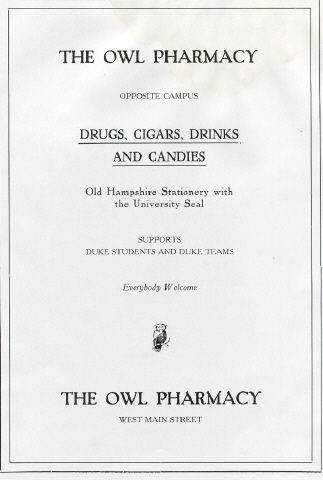
City of Ghosts
A poem by Joseph Calvin Parrish
tobacco factory of ancient brick
and elongated structures that enclose a street
aroma, sweet, rich, unchanged
industry and thousands of trees
like those pictured in history books
grand homes that sink amongst shrubbery
new and old side-by-side
one-room grocery, broken windows
hiding in forest
industrial smokestacks that are red with rust
Durham High draped upon hard soil
a yellow and brown school
and the ghosts of my family
on broken concrete
in mold and mildew
and oaks, pines
screen back porch in the city
tree roots that cling to clay
and familiar names: Duke, Gregson, Gary, Miami
this city
the monument of my family
keeper of vaults
and I see them all
in its sky and air
and yellow grass
Reprinted with permission of the author.

